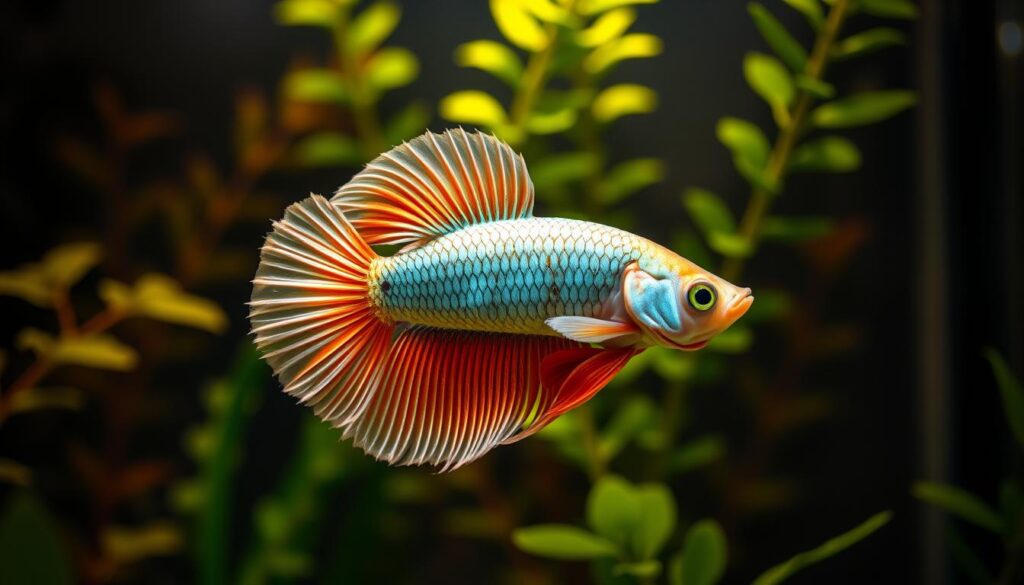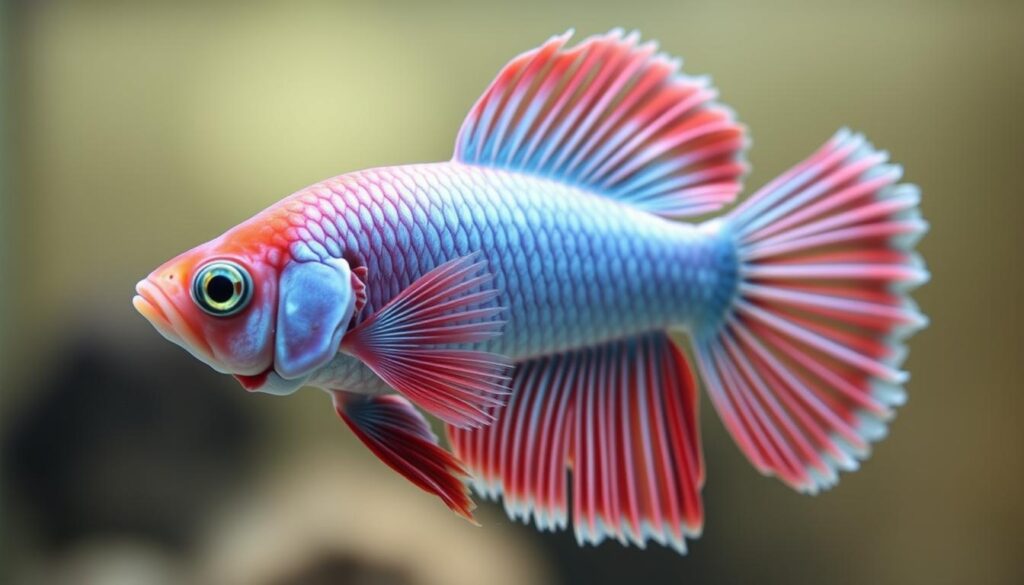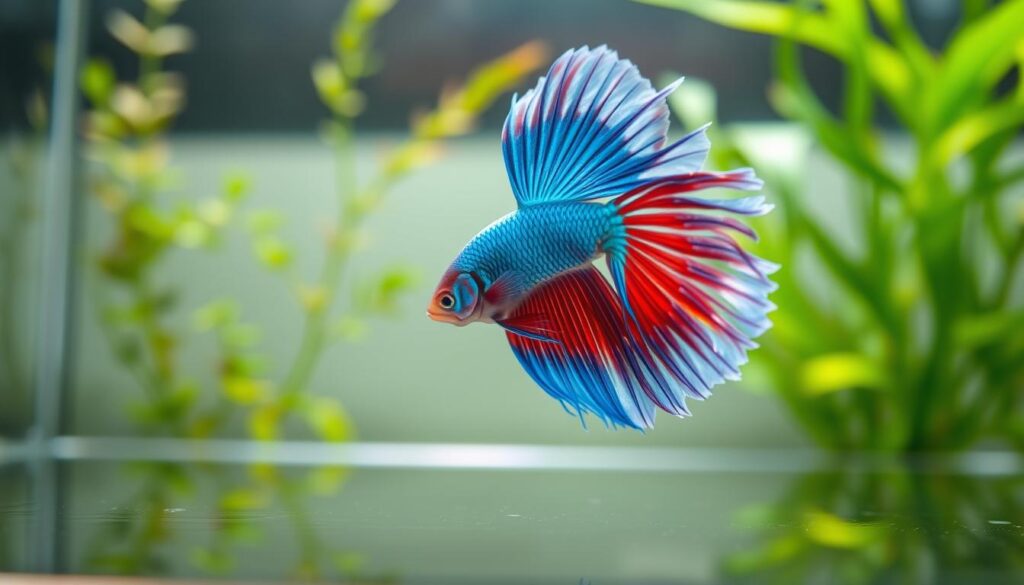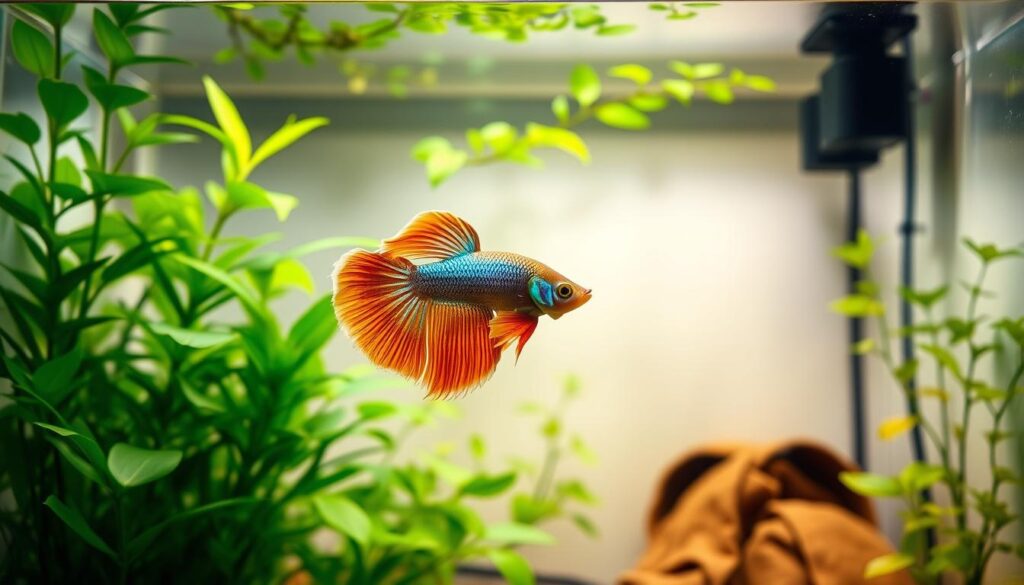If you’ve noticed your betta fish’s scales sticking out like a pinecone, you’re witnessing a serious condition known as betta fish pineconing. This unusual symptom often signals a deeper health issue—usually dropsy—and can be fatal if not treated early. In this guide, we’ll break down what betta fish pineconing really means, its causes, symptoms, and most importantly, the steps you can take right now to save your aquatic friend.
This condition, often associated with bacterial infections and poor water conditions, can be alarming when you first notice it. So, what exactly is pineconing, and how can you help your finned friend? We’re here to dive into the world of betta health issues and explore ways to identify and treat this condition.
Key Takeaways
- Understanding the causes of pineconing is crucial for effective treatment.
- Poor water conditions can contribute to the development of this condition.
- Bacterial infections are often associated with pineconing in betta fish.
- Early identification is key to providing the best chance of recovery.
- Improving water quality and administering appropriate treatment can help alleviate symptoms.
Understanding Dropsy in Betta Fish
When it comes to betta fish health issues, one condition that can be particularly alarming is dropsy. So, you’re wondering what’s behind this pineconing business? Well, it’s all about understanding dropsy in betta fish! Dropsy isn’t a disease but a sign of an underlying issue. As we dive into the world of betta care, it’s crucial to recognize the symptoms and causes of this condition.
The Science Behind Pineconing
Pineconing, or dropsy, occurs when there’s a fluid buildup inside the betta’s body, causing the scales to protrude. This is often a result of betta fish diseases such as bacterial infections, viruses, or parasites. The condition leads to a characteristic pinecone-like appearance, hence the name. Understanding the science behind pineconing is crucial for providing the right care for your betta.
Severity Levels of the Condition
The severity of dropsy can vary significantly from one betta to another. In some cases, the symptoms might be mild, with just a few scales slightly raised. In more severe cases, the entire body can become swollen, indicating a more advanced stage of the condition. Recognizing the betta fish symptoms early on is key to effective treatment.
By understanding the severity levels, you can tailor your care approach to your betta’s specific needs, improving their chances of recovery.
Identifying Betta Fish Pineconing Symptoms
Spotting the symptoms of betta fish pineconing early is crucial for effective treatment! As a betta owner, you need to be vigilant about changes in your fish’s behavior and appearance.
Early Warning Signs
Behavioral Changes
You might notice your betta becoming lethargic or showing a decreased interest in food. These behavioral changes are often the first indicators that something is amiss.
Physical Symptoms
Labored breathing and a swollen body are physical symptoms that can signal the onset of pineconing. Keep a close eye on these changes, as they can escalate quickly.
Advanced Stage Indicators
Scale Protrusion Patterns
As pineconing progresses, the scales on your betta’s body may start to protrude, giving it a characteristic ‘pinecone’ appearance. This is a clear sign that the condition has advanced.
Associated Symptoms
In addition to scale protrusion, you may observe betta fish bloating and other secondary symptoms that can complicate the condition. Monitoring these associated symptoms is vital for determining the best course of action.

By recognizing these symptoms early and understanding their progression, you can take prompt action to address the condition and improve your betta’s chances of recovery. Proper betta fish care involves being proactive about your fish’s health, and identifying pineconing symptoms is a critical part of that.
Common Causes of Pineconing in Betta Fish
When it comes to betta fish pineconing, several underlying causes can be identified, ranging from bacterial infections to dietary issues. Understanding these causes is crucial for effective treatment and prevention.
Bacterial Infections
Bacterial infections are a common cause of pineconing in betta fish. These infections often result from poor water quality or stress. When bacteria overpopulate the tank, they can cause severe damage to your betta’s health. Maintaining clean water conditions is vital to prevent such infections.
A study by aquarium experts highlights that
“Bacterial infections are a leading cause of disease in betta fish, often linked to inadequate tank maintenance.”
Ensuring regular water changes and proper filtration can significantly reduce the risk of bacterial infections.
Poor Water Conditions
Poor water conditions are another significant factor contributing to pineconing. Parameters such as pH, ammonia, and nitrite levels must be within safe ranges for betta fish. Regular water testing is essential to identify any adverse changes in water quality.
| Water Parameter | Safe Range |
|---|---|
| pH | 6.5-7.5 |
| Ammonia | 0 ppm |
| Nitrite | 0 ppm |
Dietary and Nutritional Factors
Dietary factors also play a crucial role in the health of your betta fish. Overfeeding or feeding inappropriate foods can lead to digestive issues and pineconing. A balanced diet that includes high-quality betta pellets and occasional live or frozen foods is recommended.

By addressing these common causes, you can take the first step towards treating and preventing pineconing in your betta fish. Regular monitoring and adjustments to their environment and diet can significantly improve their health and well-being.
Diagnosing Your Betta’s Condition
Diagnosing your Betta’s condition can be a challenging task, but with the right techniques, you’ll be able to identify pineconing and other health issues. As a Betta fish owner, it’s essential to be proactive in monitoring your fish’s health and taking prompt action when you notice any signs of illness.
Visual Examination Techniques
A visual examination is crucial in diagnosing pineconing and other Betta fish health issues. To start, you need to observe your Betta fish carefully, looking for any visible signs of illness or stress. Check for changes in color, posture, or behavior. A healthy Betta fish is active, vibrant, and has a robust appetite.
When examining your Betta, look for the following signs: scales that are standing out or pineconing, labored breathing, lethargy, or loss of appetite. You should also check the water quality and tank conditions to ensure they are not contributing to your fish’s condition.

Differentiating from Other Conditions
Differentiating pineconing from other conditions is vital for proper diagnosis and treatment. Two common conditions that are often confused with pineconing are bloating and swim bladder issues.
Bloating vs. Pineconing
Bloating and pineconing can appear similar at first glance, but they have distinct differences. Bloating typically involves a more uniform swelling of the body, whereas pineconing is characterized by scales that are standing out or protruding. Understanding these differences is key to diagnosing your Betta’s condition accurately.
Swim Bladder Issues vs. Dropsy
Swim bladder issues and dropsy are two separate conditions that can be confused with pineconing. Swim bladder problems often cause your Betta to have difficulty swimming or maintaining its position in the water. Dropsy, on the other hand, is a more severe condition characterized by fluid accumulation in the body, leading to swelling and potentially pineconing. A careful examination is necessary to determine the underlying cause of your Betta’s symptoms.
| Condition | Symptoms | Differences |
|---|---|---|
| Pineconing | Scales standing out, potential lethargy | Scales protrude, not uniform swelling |
| Bloating | Uniform body swelling | Swelling is uniform, not just scales |
| Swim Bladder Issues | Difficulty swimming, maintaining position | Affects swimming ability, not scale appearance |
| Dropsy | Fluid accumulation, swelling, pineconing | Severe fluid accumulation, potentially life-threatening |
By understanding these differences and using visual examination techniques, you can accurately diagnose your Betta’s condition and take the necessary steps towards treatment and recovery.
Treatment Options for Betta Fish Pineconing
Now that we’ve identified the issue, let’s dive into the treatment options for betta fish pineconing! Treating this condition effectively requires a combination of the right medication, improved water quality, and supportive care.
Medication Treatments
When it comes to treating pineconing, antibiotics are often the first line of defense against bacterial infections. Let’s explore how to use them effectively.
Antibiotics and Their Application
Administering antibiotics can be a bit tricky, but it’s crucial to follow the instructions carefully. You can use kanamycin or metronidazole as prescribed. Always complete the full course of treatment to ensure the infection is fully cleared.
Epsom Salt Baths
Epsom salt baths can help reduce swelling and improve your betta’s comfort. To prepare an Epsom salt bath, mix 1-2 teaspoons of Epsom salt with 1 gallon of water. Soak your betta for 10-15 minutes, and monitor their behavior closely.
Water Quality Management
Improving and maintaining good water quality is crucial for your betta’s recovery. Regular water changes (about 25% every week) and proper filtration can make a significant difference. Ensure that the water parameters are within the optimal range for betta fish.
| Water Parameter | Optimal Range |
|---|---|
| pH | 6.5-7.5 |
| Ammonia | 0 ppm |
| Nitrite | 0 ppm |
| Nitrate | <20 ppm |
Supportive Care Methods
Supportive care is vital for your betta’s recovery. Ensure they’re receiving a balanced diet rich in nutrients. You can also provide a stress-free environment by maintaining a comfortable temperature (around 78-82°F) and minimizing disturbances.

By combining these treatment options and providing the right care, you can help your betta fish recover from pineconing. Stay patient and observant, and don’t hesitate to seek professional advice if you’re unsure about any aspect of the treatment.
Setting Up a Hospital Tank for Treatment
When your betta fish is under the weather, a hospital tank can be a game-changer! It’s a separate environment where you can provide your betta with the care it needs to recover from pineconing. Let’s dive into the essentials of setting up this recovery haven.
Essential Equipment
To create a comfortable and safe space for your betta, you’ll need some basic equipment. A heater is crucial to maintain the optimal temperature, while a gentle filter will keep the water clean without stressing your betta. Here’s a quick rundown of what you’ll need:
- A separate tank (minimum 5 gallons)
- A heater to maintain temperature
- A gentle filter to keep water clean
- Water conditioner to remove chlorine and chloramines
Maintaining Optimal Healing Conditions
Now that you have the essential equipment, it’s time to focus on creating the perfect healing environment. This involves maintaining optimal water parameters and temperature.
Temperature Control
Temperature is a critical factor in your betta’s recovery. The ideal temperature range for betta fish is between 78°F to 82°F (25°C to 28°C). Use a reliable heater to maintain this range, and always monitor the temperature with a thermometer.
Water Parameter Management
Regular water changes and monitoring water parameters are vital. Keep the water clean and well-oxygenated, and ensure that parameters such as pH and ammonia levels are within safe ranges for your betta.
| Parameter | Ideal Range |
|---|---|
| pH | 6.5-7.5 |
| Ammonia | 0 ppm |
| Nitrite | 0 ppm |

By setting up a hospital tank with the right equipment and maintaining optimal conditions, you’ll be giving your betta the best chance to recover from pineconing. Remember, a hospital tank is a temporary but crucial step in your betta’s care journey.
Prevention Strategies for Betta Health
A healthy betta is a happy betta, and with the right preventive measures, you can ensure your pet lives a long, vibrant life. Preventing health issues in betta fish is crucial for their longevity and quality of life.
So, what can you do to keep your betta healthy? Let’s explore some effective strategies!
Read Also Mustard Betta Fish: A Striking Blend of Beauty and Bold Personality
Regular Tank Maintenance Routines
Regular tank maintenance is the backbone of betta fish care. You should perform partial water changes (about 25% every week) to keep the water fresh and clean. Regularly cleaning the gravel, decorations, and glass walls of the tank is also essential to prevent the buildup of debris and bacteria. Make sure to check your tank’s water parameters regularly to ensure they’re within the optimal range for your betta.
Optimal Feeding Practices
Feeding your betta a balanced diet is vital for their overall health. Provide a variety of nutrient-rich foods, such as high-quality commercial betta pellets, live or frozen foods like brine shrimp or bloodworms. Avoid overfeeding, as this can lead to digestive issues and water quality problems. Feed your betta only as much as they can consume within a few minutes, and consider fasting them one day a week to help maintain their digestive health.
Stress Reduction Techniques
Reducing stress is critical for maintaining your betta’s health. You can minimize stress by providing a calm and stable environment. Avoid placing their tank near drafty windows, direct sunlight, or loud appliances. Adding some plants or decorations can help create hiding places and visual barriers, making your betta feel more secure. Also, be sure to handle your betta gently and carefully when performing tank maintenance or water changes.
By implementing these prevention strategies, you’ll be well on your way to creating a healthy and thriving environment for your betta fish. Remember, a happy betta is a healthy betta!
Recovery Process and Prognosis
As you care for your betta fish recovering from pineconing, it’s essential to grasp the recovery timeline and prognosis. The journey to recovery can be complex, and understanding what to expect can make a significant difference in your betta’s care.
Timeline for Recovery
The recovery timeline for betta fish with pineconing varies significantly depending on the underlying cause and the effectiveness of the treatment. Generally, you can expect to see improvements within a few weeks if the treatment is successful. However, it’s crucial to be patient and continue with the prescribed treatment plan. Regular monitoring of your betta’s condition and adjustments to their care can significantly impact their recovery.
When to Consider Humane Euthanasia
Unfortunately, not all betta fish will recover from pineconing, and in severe cases, humane euthanasia may be the most compassionate decision to prevent further suffering. It’s a difficult choice, but considering your betta’s quality of life is essential. If your betta is experiencing chronic pain, difficulty breathing, or showing no signs of improvement despite proper care, it may be time to consider this option. Consulting with a veterinarian can provide guidance on making this heartbreaking decision.
Common Mistakes in Treating Pineconing
Treating pineconing in betta fish can be a challenging task, but avoiding common mistakes can make all the difference! When it comes tobetta fish treatment, it’s easy to get it wrong. Let’s explore the most common errors and how you can avoid them to give your betta the best chance at recovery.
Medication Errors to Avoid
One of the most significant mistakes betta owners make is misusingbetta fish medication. Using the wrong medication or incorrect dosages can do more harm than good. Always follow the instructions provided with the medication, and consult with a pet care expert if you’re unsure. For example, using antibiotics without a proper diagnosis can lead to antibiotic resistance, making it harder to treat your betta’s condition.
Environmental Management Oversights
Another critical aspect ofbetta fish treatmentis maintaining optimalbetta fish tank conditions. Neglecting water quality management can exacerbate pineconing. Regular water changes, monitoring water parameters, and ensuring proper tank maintenance are crucial. Make sure to check your tank’s water temperature, pH, and ammonia levels regularly. A well-maintained tank can significantly improve your betta’s chances of recovery.
By avoiding these common mistakes, you can significantly improve your betta’s chances of recovery. Remember,betta fish treatmentrequires patience, attention to detail, and a commitment to providing the best possible care for your betta.
Conclusion
Now that we’ve explored the causes, symptoms, and treatment options for betta fish pineconing, it’s clear that providing proper betta fish care is crucial in preventing this condition. By being proactive and knowledgeable, you can help your betta live a happy, healthy life, free from betta fish health issues.
Remember, a well-maintained tank, a balanced diet, and regular monitoring can go a long way in keeping your betta thriving. If you do encounter betta fish pineconing, don’t panic! With the right treatment and care, your betta can make a full recovery.
By following the guidelines outlined in this article, you’ll be well on your way to becoming a betta fish expert, equipped to tackle any health issues that may arise. So, take the plunge, and give your betta the care and attention they deserve – you’ll be rewarded with a happy, healthy companion!

